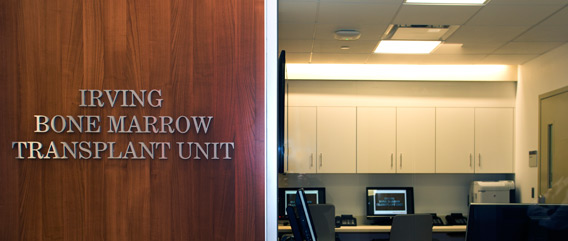Irving Bone Marrow Transplant Unit Opens in Harkness Pavilion
The Irving Bone Marrow Transplant Unit, a state-of-the-art facility for comprehensive bone marrow transplant care, opened this spring on the 11th floor of the Harkness Pavilion. The new unit features 18 inpatient rooms, a high-tech nurses’ station for individual patient monitoring, and a specialized airflow system to protect patients with weakened immune systems.
The unit, supported by a $20 million gift to NewYork-Presbyterian Hospital from Herbert and Florence Irving, delivers patient-centered care for BMT recipients and will advance research to make BMT a safe and viable lifesaving therapy for a wide range of patients.
BMT has evolved into the standard of care for patients with blood cancers, including leukemia and lymphoma, and other blood disorders, and its use is expected to grow by 20 percent over the next decade.
BMT and other forms of cellular therapies can be used to custom-tailor a patient’s immune system. The pioneering work of Megan Sykes, MD, director of the Columbia Center for Translational Immunology and the Michael J. Friedlander Professor of Medicine and professor of microbiology & immunology and surgical sciences, has demonstrated that BMT combined with organ transplantation can induce tolerance of the donated organ without the use of long-term immunosuppressant therapy. With the largest solid organ transplant program in the country, NewYork-Presbyterian will be in a position to help the BMT unit lead efforts to make combined transplant procedures the clinical standard.
The unit is led by Markus Mapara, MD, PhD, professor of medicine. Dr. Mapara plans to develop new approaches to improve the outcomes of patients undergoing hematopoietic stem cell transplantation by preventing or reducing treatment-related complications such as graft-versus-host disease and preventing recurrence of the underlying disease.
A particular focus of his research is transplants in patients who do not have matched donors. Approximately 25 percent of patients who need a bone marrow transplant have a matching donor in their family, while the remaining patients must be matched with a compatible donor in national and international registries. The chance of finding a match in registries is about 70 percent for whites but lower among ethnic minority patients. Partial matches from first-degree relatives have made BMT possible, especially in patients from ethnic minorities.
- Log in to post comments


